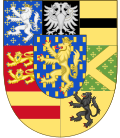
Back Huis van Nassau-Weilburg Afrikaans عائلة ناساو - فيلبيورخ Arabic Casa de Nassau-Weilburg AST Насау-Вайлбург Bulgarian Nasavsko-Weilburští Czech Nassau-Weilburg German Nassau-Weilburg Esperanto Casa de Nassau-Weilburg Spanish Principauté de Nassau-Weilbourg French Diùcachd Nassau-Weilburg Scots/Gaelic
This article needs additional citations for verification. (August 2015) |
| House of Nassau-Weilburg | |
|---|---|
 | |
| Parent house | House of Nassau[1][2] |
| Founded | 1344 |
| Founder | John I of Nassau-Weilburg |
| Current head | Henri, Grand Duke of Luxembourg (in cognatic line) |
| Titles | |
| Style(s) | His/Her Royal Highness |
| Estate(s) | |
| Dissolution | 1985 (in agnatic line after death of Grand Duchess Charlotte) |
The House of Nassau-Weilburg, a branch of the House of Nassau, ruled a division of the County of Nassau, which was a state in what is now Germany, then part of the Holy Roman Empire, from 1344 to 1806.
On 17 July 1806, upon the dissolution of the Holy Roman Empire, the principalities of Nassau-Usingen and Nassau-Weilburg both joined the Confederation of the Rhine. Under pressure from Napoleon, both principalities merged to become the Duchy of Nassau on 30 August 1806, under the joint rule of Prince Frederick August of Nassau-Usingen and his younger cousin, Prince Frederick William of Nassau-Weilburg. As Frederick August had no heirs, he agreed that Frederick William should become the sole ruler after his death. However, Frederick William died from a fall on the stairs at Schloss Weilburg on 9 January 1816 and it was his son William who later became duke of a unified Nassau.
The sovereigns of this house afterwards governed the Duchy of Nassau until 1866. Since 1890, they have reigned over the Grand Duchy of Luxembourg.
- ^ "Inoformation of the reigning House of Nassau-Weilburg". luxembourg.public.lu/en/index.html. Archived from the original on 2019-10-22. Retrieved 2019-11-03.
- ^ "Inoformation of the reigning House of Nassau-Weilburg which explicitly states the House of Nassau as its parent house" (PDF). sip.gouvernement.lu/en.html.